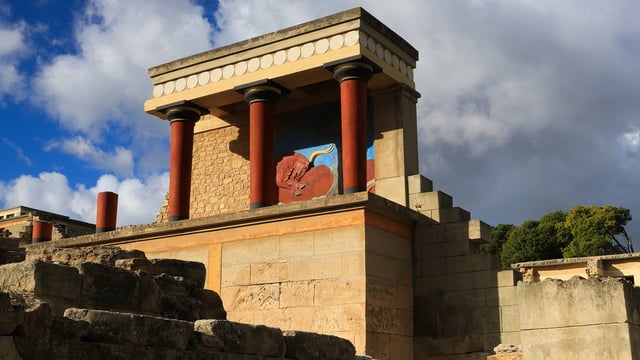- Thomas Dowson
- Last Checked and/or Updated 25 January 2023
- Greece
Recommended Skip-the-line Entry to Knossos
► This is a skip-the-line entrance ticket only.
► Option to cancel up to 24 hours before your booked time, with the option to extend this further.
► Purchase the skip-the-line ticket in advance for a day of your choice via the Tiqets website or click on the ‘book now’ button.
► Book a guided tour of the archaeological site of Knossos and the Archaeological Museum in Heraklion via the GetYourGuide website.
Or, continue reading this page for all the information you need in preparation for your visit to the Capuchin Crypt.
Archaeology Travel may earn a commission at no extra cost to you should you decide to purchase them.
Knossos Palace is one of the most important archaeological sites in Greece, and the most visited attraction on the island of Crete. Excavations began here in 1900 AD by Sir Arthur Evans and carried on for 35 years. Evans believed he had unearthed King Minos’s palace and the legendary labyrinth, a very large maze, which had been built to contain his son the Minotaur. And so Evans set about reconstructing certain features with this in mind.
Today many of his reconstructions and interpretations are questioned. Rather than being the ruins of a palace, Knossos was a ceremonial centre that was at the heart of Bronze Age communities on Crete.

Buying Tickets for Knossos Palace
How to Get to Knossos
The archaeological site of Knossos is about 5 km south of the city of Heraklion, on the north coast of Crete.
Visiting Knossos by bus
From the Central Bus Station (9 Ikarou Avenue, not far from the Heraklion Port) take Bus Number 2 to Knossos.
The bus runs fairly frequently between Heraklion and Knossos – 3 to 5 times an hour – from 08h00 to 19h00 during summer and 08h00 to 15h00 during winter.
Knossos is the final stop, and in 2019 the fee was €1.50 each way.
Alternatively, get a two-day ticket for the Heraklion Hop-On-Hop-Off Bus, that includes a stop at Knossos and many other attraction in Heraklion.
Visiting Knossos with private transport
Transport to Knossos included with guided tours
Opening Hours
1 November to 31 March: daily from 08h30 – 17h00 (last admission 16h45)
1 April to 31 August: daily from 08h00 – 20h00 (last admission 19:45)
1 September to 15 September: daily from 08h00 – 19h30 (last admission 19:15)
16 September to 30 September: daily from 08h00 – 19h00 (last admission 18:45)
1 October to 15 October: daily from 08h00 – 18h30 (last admission 18:15)
16 October to 31 October: daily from 08h00 – 18h00 (last admission 17:45)
Closed on the following days: 1 January, 25 March, Good Friday, Holy Saturday, 1 May, Easter Sunday, 15 August, 28 October, 25 December, 26 December.
Ticket Prices
Full: €15
Reduced: €8
Facilities

Add Knossos to Your Itineraries & Travel Lists
If you are planning a trip to France to see the cave art, you can create your own travel lists (such as places you have been to, places you would like to visit) and an itinerary for your visit. These can also be shared with your friends and on social media. You can see how this is done by watching our Using the Itinerary video on YouTube, or reading the Using the Itinerary page.
For more ideas and suggestions, sites and museums to visit, see our Island Guide to Crete, and our Greece Travel Guide.
Knossos
Knossos is an important archaeological site that figures prominently in the history and development of archaeology. Excavations began in 1900 by Sir Arthur Evans and carried on for 35 years. Although many of his reconstructions and interpretations are now questioned, it is thought that the ruins are those of a political and ceremonial centre that was at the heart of Bronze Age communities on Crete. There is also archaeological evidence at the site for Neolithic and later Classical occupations.




